This oven baked salmon uses four simple ingredients and takes less than 20 minutes. The fish has a juicy inside and crispy outside — the perfect texture duo!
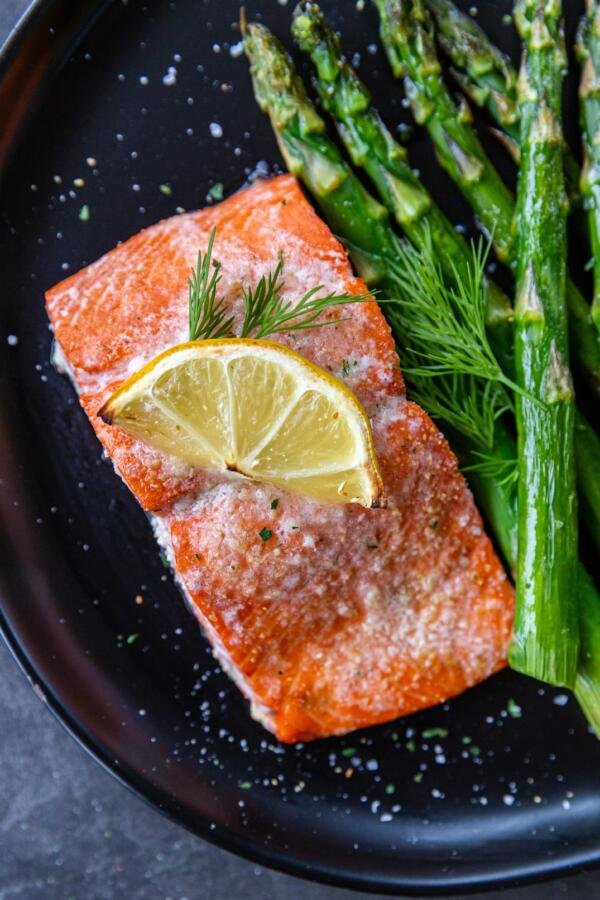
Cooking only a few portions? Save on your energy bill and use the air fryer to make this air fryer salmon instead!
Oven Baked Salmon Video
How To Bake Salmon
Most people imagine fish recipes take a lot of effort and time to make. Well… surprise! This baked salmon takes only five minutes of prep time and a quick 12 minutes to bake.
- Prepare the oven and ingredients: Preheat the oven to 425°F and line a rimmed baking sheet with foil. Prep the ingredients and pat the salmon filets dry with a paper towel.
- Season the salmon: Place the salmon skin side down on the baking sheet. Top the salmon with slices of butter, sprinkle on the garlic parsley salt, and top with lemon slices.
- Bake: Bake the salmon for about 6-8 minutes or until the salmon is almost fully cooked. Then, turn the broiler to high and cook for an additional 3-4 minutes.
Hot tip: Choose salmon pieces which are similar in thickness and size. This ensures each filet cooks at the same rate to prevent over or under-cooking.




Tips for the Best Oven Baked Salmon
Look no further — this is the only and best baked salmon recipe you’ll ever need! Follow these tips to make the whole process crazy easy and the salmon crazy tasty.
- Make clean-up easy: For a super quick clean up, line your baking sheet with foil or parchment paper. As the salmon bakes, the skin will stick to the foil instead of the pan. Then, toss the skin along with the foil into the trash. Or, if you prefer to eat the skin, use parchment paper.
- Broil for extra crispiness: To caramelize the crust, turn the oven to a high broil for 1-2 minutes right before the salmon is fully cooked.
- Avoid overcooking: When salmon is overcooked, it becomes bland and dry. To avoid this, cook it until the internal temperature of the thickest part reaches 145°F with an instant read thermometer. Or, test the salmon by pressing into it with a fork — it should easily flake along the white lines. The color of the salmon will be an opaque pink when cooked. It is okay to have a little translucency in the very middle.
- Add more flavor: To customize this baked salmon recipe and make it your own, add a few extra spices. Sprinkle a teaspoon of black pepper, paprika, seafood seasoning, or any of your other favorite seasonings before baking.
- Brush on the melted butter: Once the salmon is baked, remove it from the oven and lightly brush on the leftover melted butter from the pan for more flavor and juiciness.
Hot tip: For a dairy-free alternative, use olive oil instead of butter. Combine the spices and olive oil together in a small bowl, then brush onto both sides of the salmon before baking.
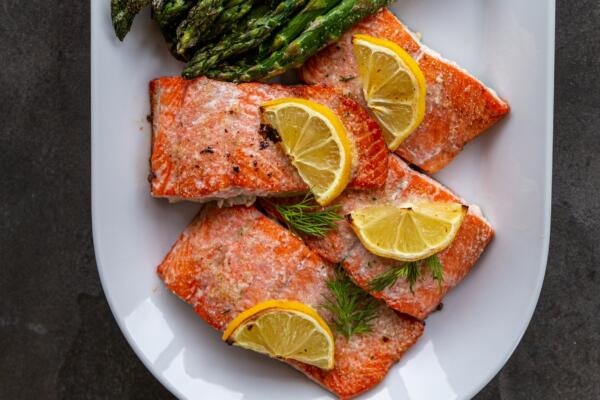
How Long To Bake Salmon At Different Temperatures
Choose your ideal salmon cooking temperature depending on how quickly you want it to be done, as well as what texture you prefer. For a quicker bake and a crispier result, choose a high temperature. For a slower bake and more tender fillet, opt for a lower temperature.
- 375°F: If baking at 375°F, bake for a maximum of 10-12 minutes, plus a few minutes under the broiler.
- 400°F: If baking at 400°F, bake for a maximum of 8-10 minutes, plus a few minutes under the broiler.
- 425°F: If baking at 425°F, bake for a maximum of 6-8 minutes, plus a few minutes under the broiler.
Serving Oven Baked Salmon
Oven baked salmon is super versatile and great with a variety of side dishes. For a dinner pairing, serve it with a grain like rice or quinoa, plus a garden salad or Caesar salad. Alternatively, pair with parmesan risotto and roasted broccolini, or serve the salmon with mashed or scalloped potatoes and oven roasted asparagus for a fancier presentation. For a fun twist, I sometimes serve this salmon with fresh pineapple salsa on top!
Storing Leftover Baked Salmon
Leftover baked salmon is best stored for up to three days in an airtight container and refrigerated. Avoid freezing cooked salmon because it tends to dry out when thawed and reheated.
FAQ
Does it matter what type of salmon I bake with?
In general, the type of salmon does not matter too much for oven baking. For a milder fishy taste, opt for Atlantic salmon or coho salmon. For a stronger fishy taste but meatier texture, use king salmon.
Can I cook salmon fillets straight from frozen?
Yes, it is safe to cook frozen salmon fillets. However, salmon usually tastes better and has a more pleasant texture when thawed first, then cooked.
Is salmon skin safe to eat?
Yes, salmon skin is safe to eat. Salmon skin has many nutritional benefits too, like omega-3 fatty acids, protein, and collagen.
More Salmon Recipes
- Brown Sugar Glazed Salmon – a sweet glaze made with just 3 ingredients.
- Perfect Air Fryer Salmon – under 15 minutes to cook and a crispy crust.
- Baked Teriyaki Salmon– easy to make, with the tastiest marinade.
- Canned Salmon Dip – Salmon and cream cheese-based dip that is perfect with crackers or veggies.
- Salmon Chowder – comforting, creamy, and made with smoked salmon.
Recipe
Ingredients
- 2 lb salmon fillet
- 4 tbsp Unsalted Butter
- 1 tbsp garlic parsley salt to taste
- 1 lemon sliced
Instructions
- Preheat the oven to 425°F. Pat salmon dry with a paper towel.
- Place the salmon pieces skin side down on a baking sheet lined with foil. Top the salmon with pieces of butter and sprinkle generously with the garlic salt. Finally, top the salmon with lemon slices.
- Bake salmon at 425°F for 6-8 minutes, depending on the thickness of the salmon fillet, until the salmon is almost cooked. Then, turn the oven up to high broil and broil for 3-4 more minutes.
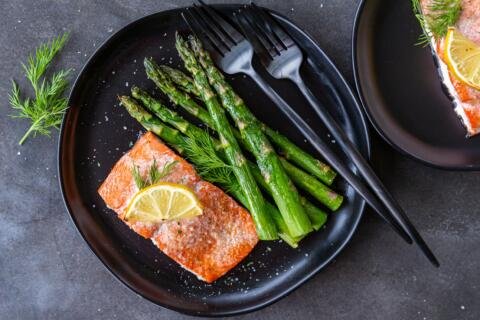
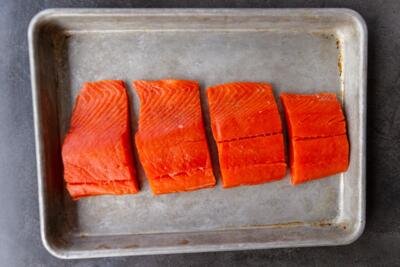
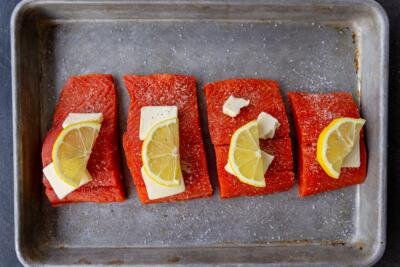
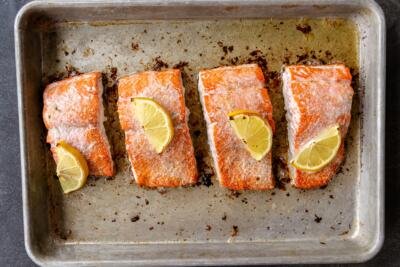

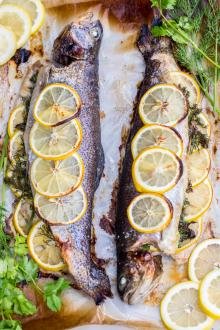
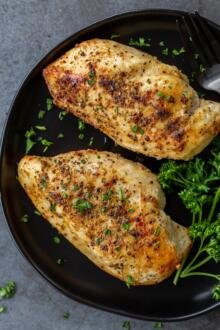
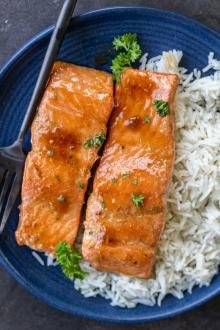
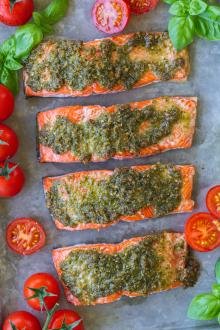

My salmon skins got stuck to the pan :/
Hi there Grace, I am sorry to hear that! Here is a tip that I have on the recipe post. copied from the blog post: Make Clean-Up Easy – Line your baking sheet with foil. When salmon bakes, the skin will stick to the foil instead of your pan. This will allow you to easily remove the salmon from the pan. The leftover skin can be tossed together with the foil.
Salmon is a pretty forgiving protein to cook with. You don't need many ingredients to make it delicious, and you can always cook it alongside a vegetable for a simple meal.
Agreed!! Salmon is delicious and you can pair it with so many things!
Best salmon I’ve ever made! This recipe is easy and simple but tastes amazing. Thank you for sharing.
I'm glad you enjoyed the recipe, thank you for your feedback!
So buttery, it's just melts in your mouth! I could eat this daily!!
I'm glad you enjoyed the recipe, thank you for taking the time to comment!
Everyone loved this Baked Salmon! SO easy and incredibly delicious!!
Thank you, Katerina, I'm so glad you enjoyed it!
When you put salmon on top rack and turn on high broil, do you cover salmon with foil or leave it open?
I dont cover it, just leave it as is. If the rack is too close to the top you may want to lower it.
Hi Natalya! Love salmon.i come from a family of fisherman and we just never get tired of eating fish.Great work!!
Perfect!! I wish we fished, I love the fresh smell of fish. Sometimes I get lucky with friends 🙂